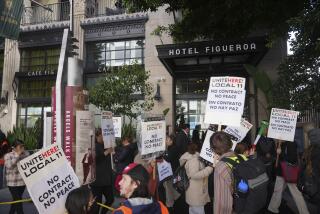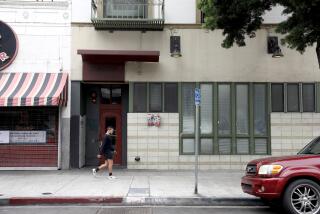A Tale of Two Hotels -- and the Future of a City
While the pace of development in downtown Los Angeles is generating excitement and momentum, the fortunes of two stately early 20th century hotels symbolize the political challenges of melding the old and the new.
The renovated St. George Hotel, with its ocher and beige modernist exterior, could pass as a smart new hostelry catering to the trendy and the famous. That it sits at the edge of skid row and houses formerly homeless people augurs well for those who believe such low-rent single-room-occupancy hotels are essential to stem the tide of homelessness.
A few blocks away at the Bristol Hotel, formerly homeless residents were evicted so it could be converted into a luxury boutique hotel.
The area is undergoing a makeover with new cultural institutions, an influx of residents and demand for residential lofts and swanky visitor accommodations. At the same time, it hosts one of the nation’s largest concentrations of homeless people and services that aid them.
The city’s policymakers are trying to navigate a path that meets the needs of downtown’s most vulnerable residents without blunting a renaissance that could reshape the skyline and add billions to the area’s value.
Los Angeles Mayor Antonio Villaraigosa last week said he would work to put a $1-billion bond measure to support affordable housing before voters, and he proposed using $50 million in city funds to develop low-income housing, including the rehabilitation of low-rent residential hotels.
Meanwhile, the City Council is considering a one-year citywide moratorium on the demolition of single-room-occupancy hotels -- often the housing of last resort -- until it can develop a preservation strategy.
“We’ve never gone through such a sustained recovery period, with projects in the pipeline that will bring jobs to this area,” said Councilwoman Jan Perry, who proposed the moratorium.
Perry represents part of downtown’s financial district as well as the poor neighborhoods of skid row and south Los Angeles. “But we have a window of opportunity, and I didn’t want to waste that. It’s entirely possible to create projects with mixedincome [residents] living side by side.”
The building industry is viewing the proposed moratorium cautiously.
“We always want public officials to recognize we’re in a housing deficit and, as they’re making policies, to think about the impact on the entire range of housing,” said Holly Schroeder, chief executive officer of the Building Industry Assn. of Greater Los Angeles and Ventura.
Downtown’s once sporadic attempts at enlivening its core have taken flight in the last two years, with residential building conversions and new restaurants and nightspots. Developers have announced plans for L.A. Live, a massive hotel and entertainment center near Staples Center, and a residential, cultural and entertainment corridor on Grand Avenue.
Trend-spotters are awaiting the opening of the Gansevoort West, a luxury hotel at 9th Street and Grand Avenue. And loft conversions are planned at the El Dorado-Pacific Grand Hotel and possibly the ornate Alexandria Hotel.
The Los Angeles County Economic Development Corp., a private business leadership organization, is studying the financial repercussions.
“Our sense is that the impact on jobs and tax revenue of the downtown gentrification or renaissance has been significant and will continue to be significant,” said Jack Kyser, senior economist at the corporation.
Such benefits will be hard for policymakers to ignore. A year ago, Villaraigosa, then a City Council member, co-sponsored a motion to begin exploring how single-room occupancy hotels might be preserved. At a recent news conference to praise the economic engine that is the entertainment industry, Villaraigosa said he would wait to see the specifics of a preservation ordinance before offering support or opposition.
“These issues are complex and multi-pronged,” he said. “You have to bring everyone in, solicit their views and find common ground.”
The city previously has imposed moratoriums on demolition and conversion of single-room-occupancy hotels. The last one expired in 1994. Since then, according to the Los Angeles Housing Department, at least 10 single-room occupancy hotels with more than 1,087 units have been demolished, closed because of nuisance claims or converted to upscale lofts.
Meanwhile, housing officials are monitoring an additional seven buildings, with 2,270 units, that could be earmarked for conversion to luxury lofts or hotels.
The typical resident of a single-room-occupancy hotel is an African American man who receives public assistance of about $221 a month. Only about 10% are employed, and many suffer from chronic diseases, substance abuse, mental illness and other disabilities, according to the housing department.
Monthly rent for these units ranges from $280 to $350, but federal subsidies allow some residents to pay only about 30% of their monthly income for rent.
Even as development continues downtown, it is unlikely to smother the core of skid row, where many single-room-occupancy hotels are located, officials said. Many hotels are too dilapidated to appeal to developers, and uprooting more residents might prove politically unpalatable.
“Many of these places house the frail and elderly, and it may be the last stop for them,” Perry said.
The turnover at the 103-unit Bristol Hotel was widely publicized after advocates alleged that residents were forced out without enough warning or proper compensation, a charge the previous owners denied.
The new owner, Adolfo Suaya, who also owns the Gaucho Grill restaurant chain, hoped to transform the seven-story 1920 building into an 84-room hotel with a rooftop bar, a basement nightclub, a restaurant and a movie theater for guests. A Suaya representative said plans are on hold.
Advocates agree that many hotel tenants live on the precipice and could fall back into homelessness.
“When these places stop being residential hotels, one result is that homelessness goes up,” said Mike Alvidrez, executive director of Skid Row Housing Trust, the nonprofit developer of the St. George Hotel project.
The six-story, 86-room St. George was built in 1904 and, because of its proximity to the theater district, was frequented by actors and other performers. After a $9-million renovation last year, it provides subsidized housing for homeless people with HIV, AIDS, mental illnesses and other disabilities.
The trust operates 1,180 units in 19 hotels, with an 89-unit building under construction, a 115-unit building in development and a 76-unit building in escrow. All are downtown. But Alvidrez said he and other developers of housing for low-income tenants are being pinched by high land costs.
Officials are looking at other cities, including San Diego and San Francisco, which enacted preservation ordinances allowing owners to demolish or convert single-room-occupancy hotels only if they replace the units or pay replacement fees, according to the Los Angeles Housing Department report.
In San Francisco, which has about 520 residential hotels with more than 19,000 units, displaced residents get relocation fees and have first right of refusal for replacement units.
The effect has been to greatly minimize conversions and demolitions, said San Francisco’s chief building inspector, Rosemary Bosque.
More to Read
Sign up for Essential California
The most important California stories and recommendations in your inbox every morning.
You may occasionally receive promotional content from the Los Angeles Times.











